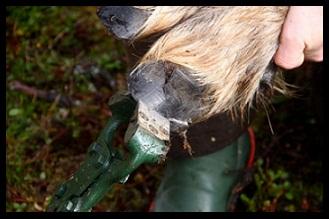The hoof status of musk ox housed in different conditions.

By improving the body condition of the animal during more activity, the hoof status is getting better, if the substrate is right. An improved hoof status before the reintroduction could prevent problems in the beginning of the release to the wild, by facilitating the animal to keep up with the herb pace etc. Studies by Lewis (1995) and Hahn et al (1986) showed that a hoof is growing normally about 0.6-0.9 cm/month, compared to our study where the hoof growth was higher than normal. The hoofs of the musk ox in Tännäs were growing about 4 cm under 73 days; growth rate of hoofs was 1.6 cm/month. The hoofs of the musk ox in Kolmården were growing about 5 cm under 86 days; growth rate of the hoof was 1.8 cm/month. The main reason for that could be the ground was too soft, that the hoof did not wear naturally and the food quality was too high for a musk ox. It has been shown that high nutrition levels in the food affect the animals hoof growth rate negatively, by overgrowth (Marma, 1972; Wallach and Boever, 1983; Liesegang et al., 2001). Changing of the ground substrata could help to wear the hoofs naturally, for example the musk ox “Willy” hoofs was in better conditions after the time in the wild because of the rocky substrata (Begnt Röken and Torsten Möller). Even if the Tännäs musk ox has larger area to move on compared to Kolmården, the musk ox in both places needed help to trim the hoofs, unfortunately is this a common problem for animals in captivity (Groves, 1992, Masui, et al., 1975).
Responsible for this page:
Director of undergraduate studies Biology
Last updated:
05/17/11
